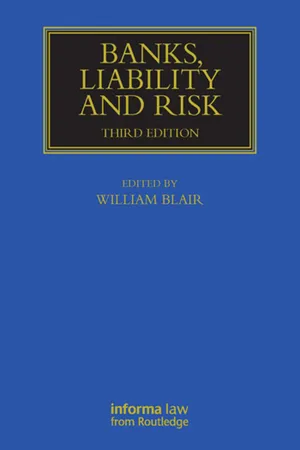Law
Contract Liability
Contract liability refers to the legal responsibility that arises from a breach of contract. When one party fails to fulfill their obligations as outlined in a contract, they may be held liable for any resulting damages or losses suffered by the other party. This liability is typically determined based on the terms and conditions specified in the contract.
Written by Perlego with AI-assistance
Related key terms
6 Key excerpts on "Contract Liability"
- eBook - ePub
- Andrew Mitchell(Author)
- 2008(Publication Date)
- Routledge-Cavendish(Publisher)
15 Introduction to Contract Liability This topic enables you:- To appreciate the need for a law of contract.
- To draw a distinction between binding and non-binding agreements.
- To understand and explain the ingredients required for a valid contract (offer, acceptance, consideration and intention to create legal relations).
- To apply your knowledge of contract formation.
- To understand the meaning and consequences of a breach of contract.
WHAT IS THE LAW OF CONTRACT?
The law of contract exists to make sense of agreements, be they small or large, formal or informal, made over the counter or over the internet. Thus, the law of contract is relevant to us every time we go shopping and it is relevant to huge corporations that make multi-million dollar deals with each other. In addition, it identifies those agreements that the law will enforce and those that fall outside the legal framework. Concepts of ‘mutuality’, ‘exchange’, ‘promise’ and ‘bargain’ are central to an understanding of enforceable agreements. Those who enter into agreements do so for mutual benefit and on the basis of promises that will be fulfilled. Both parties hope to gain something of value, hence the idea of a bargain. The retailer who sells goods will hope to make a profit from the activity; the consumer who buys from that retailer is fulfilling a need or want and sees the value of the purchase. The goods are exchanged for a monetary price, with the parties’ intentions clear: they intend this to be a legally binding purchase, so that the retailer can record his sale of stock and the consumer can seek redress should there be a problem with the goods.The law of contract has developed over the centuries in the courts, with a framework that reflects experience in the light of changing commercial activities and practices. It is therefore a largely common law - eBook - ePub
- William Blair, William Blair(Authors)
- 2020(Publication Date)
- Informa Law from Routledge(Publisher)
The liability component must begin with a legal duty—whether tort or contract. Once a legal duty is recognised, it must be breached in order to sustain a recovery. (i) Tort 12.171 Tort duties arise from common law recognition that certain obligations are owed by people to the world at large. These duties are not dependent upon an agreement between parties, but rather, reflect obligations or conduct between parties as their actions affect each other—by negligence or otherwise. 12.172 Tort duties arise from involuntary relationships among parties. No voluntary privity of contract exists. Rather, one party acts in such a manner that the law will recognise a wrong by a party interfering with personal health or property of another party—whether intentionally or negligently. Examples of these tort duties include the duty to drive a car with reasonable care, the duty to manufacture goods free of unreasonably dangerous defects, and the duty not to assault or unreasonably interfere with the physical well-being of another. 320. E.g. 18 U.S.C. section 215 (bank bribery), 18 U.S.C. ss. 656-657 (misapplication of funds), ss. 1001, 1005, 1006 (false entries), 18 U.S.C. section 1014 (wilful overvaluation of assets), 18 U.S.C. ss. 1341 & 1343 (mail and wire fraud), 18 U.S.C. section 1344 (financial institution fraud), 18 U.S.C. section 2113(b) (larceny), 18 U.S.C. sections 371 (criminal conspiracy), 18 U.S.C. s. 1956 (money laundering) as well as criminal liability under RICO and the securities laws. See generally, Norton–Baggett–Block, supra, fn. 3, Ch. 11. 12.173 These common law obligations, among citizens at large, are governed by an objective standard—how the ubiquitous “reasonable person” would act in the same or similar circumstances. This standard or duty of performance is not founded upon a voluntary bargain negotiated and agreed between parties—there are no subjective agreed obligations between parties - eBook - ePub
Construction Contracts
Law and Management
- Will Hughes, Ronan Champion, John Murdoch(Authors)
- 2015(Publication Date)
- Routledge(Publisher)
10 Liability in contract and tortWhere a contract has been properly made, in terms of the criteria laid out in the previous Chapter, it then becomes necessary to identify precisely what obligations it imposes on the parties – that is to say, what terms it includes. This is because where any party fails without lawful excuse to perform fully and exactly a contractual obligation, that party is guilty of a breach of contract. In considering this question, what emerges is that there are three types of contractual term: those express terms which are contained in the main contractual document itself; those (also express terms ) contained in other documents to which the main contract document refers; and those terms which are implied by law.In addition to those obligations created by a contract, a party may incur legal liability under the law of tort. The most important example of this type of liability is that based on negligence.10.1 EXPRESS TERMS
10.1.1 Terms and representations
Since English law does not as a general rule require a contract to be made in any particular form (see Section 9.2.6 ), it is in principle possible for the parties’ agreement to be spread over a number of documents, and even to include oral statements. Even where the parties have eventually signed a document described as ‘the contract’, it is open to a court to decide that this document does not paint a complete picture, and that the true contract consists of that document plus other terms. However, a court will not be quick to do this, for there is a presumption that a written document that appears to contain all the terms of a contract in fact does so.The result of these principles of contract law is the creation of some uncertainty regarding the status of a statement or promise made by one party to the other during the course of negotiations leading to the signing of a formal contract. Such a statement (which might be oral, or might equally be contained in, say, a letter) can be treated in law as a term of the contract. In this case, if it is untrue, the innocent party may bring an action for breach of contract. Alternatively, if it has operated as an inducement to the other party to enter into the contract, the statement may be treated as a misrepresentation, in which case the legal remedies available will depend on whether it was made fraudulently, negligently or innocently. This is not the place to discuss the remedies for misrepresentation, which will be found in any textbook on the law of contract. Suffice it to say that they are generally less beneficial to the innocent party than a right to sue for breach of contract. - Sarah Lupton(Author)
- 2013(Publication Date)
- Wiley-Blackwell(Publisher)
Chapter 2 Liability under ContractThe designer can become liable for a design error under the law of contract, or tort, or, in some instances, under statute (as a criminal liability, and to those who have statutory rights). All three liabilities can coexist for the same error, but the starting point in assessing any liability is normally to examine the terms of any contract entered into by the designer. This section sets out the broad parameters of relevant contract law. Tort law and statute are dealt with in subsequent chapters.An examination of the contract between parties is the first step in establishing the nature and extent of any liability for design. In the case of design consultants, this would be the terms of engagement with their clients, whereas with contractors it would be the building contract. Normally contractual obligations are owed only to the client commissioning the design services, although collateral warranties, assignment, and the Contracts (Rights of Third Parties) Act 1999 may create liabilities to other parties (people other than the client) as well. In the UK there have traditionally been few legislative controls over the terms parties may agree (under the principle termed ‘freedom to contract’). This is in contrast to many other EU countries, where the obligations that may be agreed between parties are often highly regulated under the country’s Civil Code, so that the Code will be a primary reference in determining these obligations (see Chapters 17 and 18). In the UK the agreed terms will be the main determining factor, and these vary considerably from project to project. There are, of course, widely used standard form contracts published by a variety of private and public institutions, but the range has increased rapidly over recent years. In addition (and perhaps unfortunately), parties in the UK are often asked to enter into contracts on non-standard or amended terms.1 It is notable that in a recent move to reduce inefficiency and waste in construction procurement, the government has stated its intention to ‘move towards using only standard forms of contract with minimal amendment for all new central government procurement activity’,2- Roger ter Haar, Anna Laney, Marshall Levine(Authors)
- 2016(Publication Date)
- Informa Law from Routledge(Publisher)
Chapter 3 Legal liability 1 Introduction 3.1 By the very nature of a construction site, where heavy machinery and plant is engaged in close proximity to workers and buildings, often in confined spaces, the risk of accidents involving personal injury and property damage is always present, despite stringent safety regulations. Chapter 28 below explains the law and practice in respect of the health and safety obligations under statute. 3.2 In addition, new and developing technology in design and construction means that some defects in projects are almost bound to occur and may well be expensive to repair. Due to the multi-party involvement in the design and construction process, combined with probable successive multiple ownership of the completed project, comparatively few parties involved are likely to be in a contractual relationship with one another. In consequence tort-based liability is likely to be an important consideration, in addition to the rights and liabilities that arise out of contract. 3.3 The main heads of civil liability under which an aggrieved party can bring his action include: (1) negligence; (2) nuisance; (3) strict liability; (4) trespass to land; (5) breach of statutory duty; and (6) contractual liability. 3.4 Items (1) to (5) are generally referred to as torts. Recoverable losses in tort are broadly limited to losses involving physical harm to persons or property. Generally the law is restrictive as to the extent that pure economic losses are recoverable in tort. The law of contract does not make this distinction and express wording within building contracts is liable to widen the liabilities of the parties to a contract beyond their normal rights, duties and liabilities under the law of tort- eBook - ePub
Business Law
A Straightforward Guide
- (Author)
- 2014(Publication Date)
- Straightforward Publishing Digital(Publisher)
Ch. 1
BUSINESS LAW-THE LAW OF CONTRACT
Underpinning all contracts are four main principles:
1) A contract is an agreement between the parties to that contract-one person makes an offer and the other accepts that offer 2) Both parties have an intention to be legally bound by the agreement-this is usually known as an intention to create legal relations3) Parties to the agreement need to be absolutely clear as to the terms of the agreement – this is the main area of contention with contracts, as we will see laterc4) There must be consideration provided by each of the parties to the contract – this means that one person promises to give or deliver and the other promises to pay. The offer and the payment – either monetary or in kind - is the consideration. When making a contract, or entering into a contract all parties to the contract must have the legal capacity to enter into a contract. Very importantly, a contract, in most cases, does not have to be in writing – a piece of paper is not necessary, the agreement and evidence of that agreement forms the basis of contract. There are a few important exceptions, including contracts relating to interests in land (Law of property (Miscellaneous Provisions) Act 1989, s 2(1)) and consumer credit (Consumer Credit Act 1974).Other factors affecting formation include: • Form-the way the contract is created (e.g. the sale of land can only be made in the form of a deed) Form is an issue with specialty contracts but not with simple contracts• Privity of contract and the rights of third parties-generally a contract is only enforceable by or against a party to it, subject to exceptions and certain third party rights are now protected in the Contracts (Rights of Third Parties) Act 1999.The nature of contracts – unilateral and bilateral contracts
The majority of contracts entered into are known as Bilateral contracts. This quite simply means that each party to a contract agrees to take on an obligation. This obligation is underpinned by a promise to give something to the other party. A Unilateral contract will arise where one party to the contract will make a promise to do something (usually to pay a sum of money) if the other party carries out a certain task. Examples of this are where you might undertake to pay someone a sum of money if they shave off their hair for charity or give up smoking. Estate agents enter into unilateral contracts whereby a percentage of sales go to the agent if they sell the property. However, the agent is not legally bound to sell the property, just to try to sell it.
Learn about this page
Index pages curate the most relevant extracts from our library of academic textbooks. They’ve been created using an in-house natural language model (NLM), each adding context and meaning to key research topics.





